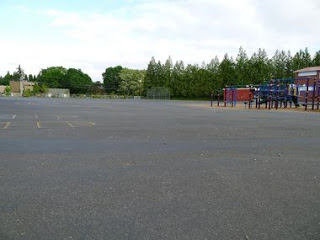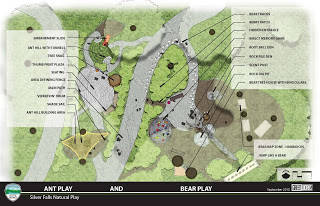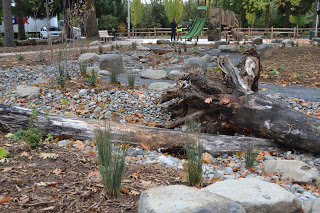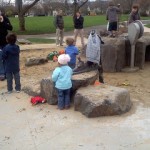Removing Asphalt to Build a Natural Playground
It seems that playgrounds consisting of a sea of asphalt with a few pieces of playground equipment off to the side have been the norm for a long time. Some of us think that it has been the norm for too long!
We want to see this…
where there use to be this…
 |
1 Removing asphalt can be a tricky project and I have found a few reoccurring issues that should be addressed. If you can jump through a few hoops it can be one of the most rewarding projects for your school or playground.
Make sure you maintain the amount of parking required by code (In Portland OR check here). Although you may not want to use the parking spaces. There is often a minimum amount of spaces required. If you have to keep the spaces in the long run, but don’t need them for the current building use consider some creative building on top of the asphalt.
| Marylhurst Early Childhood Center in Oregon City – under ‘construction’. They segmented off part of the unused parking area for play by using planters and biobags. |
2 Soil Tests
It is always a good idea to test the soil under the asphalt. Depave a Portland Organization specializing in pavement removal says,
This is great advice especially when kids, gardening, or water are involved. Depave has more advice in their how to depave guide.
3 Water and Traffic Flow
Take a good look at your site and make sure the asphalt removal is not going to trigger any new problems. Asphalt conveys water well from one area to another, soil and play areas may erode under the same water forces. Is there anything draining to the asphalt? Where will the water go once the asphalt is removed? This is a great opportunity to incorporate stormwater features and rain gardens.
Also consider traffic. How will people get around in the new area? What effects will this have on the new uses of the space?
| Rainwater Feature at Mount Hood Community College Early Childhood Center. It takes water from the roof top to a playground stormwater swale. |
4 Create a New Vision Plan
Develop a site plan that outlines what you will do after the asphalt is removed. Remember that under the asphalt is often 4″ to 6″ of rock on top of very compacted soils. Plan to help bring your soils back to life through aeration and added nutrients.
 |
| Create a Concept Plan for the new area that includes all of the proposed elements to scale |
5 Removal and Disposal
Always call before you dig! Running into an underground line can be a very big danger. Asphalt is also softer and lighter than concrete and is not suitable for reuse. It is readily recycled by pavement processing companies. It is not something you want to bury on your site. the National Asphalt Pavement Association has further information and resources.
6 Implement Your New Design
Now the fun can start! I would love to see your success stories of children’s spaces built after asphalt removal.





Thanks for such sensible advice. Here in Scotland the cost of a natural playground is just more than to put asphalt down so this is not a justifiable excuse.
Thanks for your comment. I think the same is true here; play areas are usually more expensive. In so many cases at some point in the site history someone decided to pave the whole site. It is a hassle at the very least to undo it.